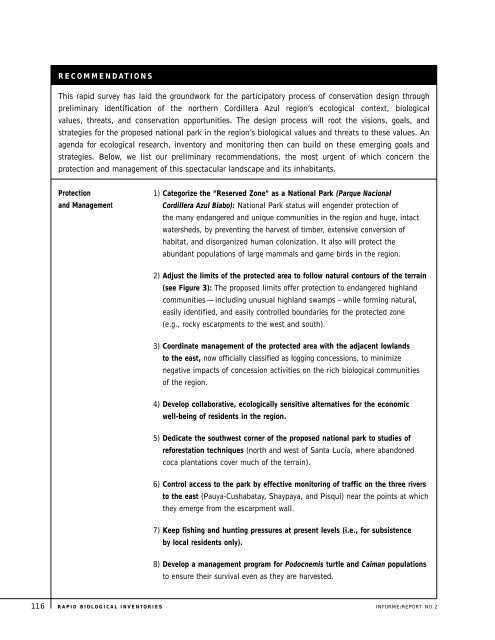RBI 02: Cordillera Azul - Espanol - The Field Museum
RBI 02: Cordillera Azul - Espanol - The Field Museum
RBI 02: Cordillera Azul - Espanol - The Field Museum
You also want an ePaper? Increase the reach of your titles
YUMPU automatically turns print PDFs into web optimized ePapers that Google loves.
116<br />
RECOMMENDATIONS<br />
This rapid survey has laid the groundwork for the participatory process of conservation design through<br />
preliminary identification of the northern <strong>Cordillera</strong> <strong>Azul</strong> region’s ecological context, biological<br />
values, threats, and conservation opportunities. <strong>The</strong> design process will root the visions, goals, and<br />
strategies for the proposed national park in the region’s biological values and threats to these values. An<br />
agenda for ecological research, inventory and monitoring then can build on these emerging goals and<br />
strategies. Below, we list our preliminary recommendations, the most urgent of which concern the<br />
protection and management of this spectacular landscape and its inhabitants.<br />
Protection<br />
and Management<br />
1) Categorize the “Reserved Zone” as a National Park (Parque Nacional<br />
<strong>Cordillera</strong> <strong>Azul</strong> Biabo): National Park status will engender protection of<br />
the many endangered and unique communities in the region and huge, intact<br />
watersheds, by preventing the harvest of timber, extensive conversion of<br />
habitat, and disorganized human colonization. It also will protect the<br />
abundant populations of large mammals and game birds in the region.<br />
2) Adjust the limits of the protected area to follow natural contours of the terrain<br />
(see Figure 3): <strong>The</strong> proposed limits offer protection to endangered highland<br />
communities—including unusual highland swamps – while forming natural,<br />
easily identified, and easily controlled boundaries for the protected zone<br />
(e.g., rocky escarpments to the west and south).<br />
3) Coordinate management of the protected area with the adjacent lowlands<br />
to the east, now officially classified as logging concessions, to minimize<br />
negative impacts of concession activities on the rich biological communities<br />
of the region.<br />
4) Develop collaborative, ecologically sensitive alternatives for the economic<br />
well-being of residents in the region.<br />
5) Dedicate the southwest corner of the proposed national park to studies of<br />
reforestation techniques (north and west of Santa Lucía, where abandoned<br />
coca plantations cover much of the terrain).<br />
6) Control access to the park by effective monitoring of traffic on the three rivers<br />
to the east (Pauya-Cushabatay, Shaypaya, and Pisqui) near the points at which<br />
they emerge from the escarpment wall.<br />
7) Keep fishing and hunting pressures at present levels (i.e., for subsistence<br />
by local residents only).<br />
8) Develop a management program for Podocnemis turtle and Caiman populations<br />
to ensure their survival even as they are harvested.<br />
RAPID BIOLOGICAL INVENTORIES INFORME/REPORT NO.2

















